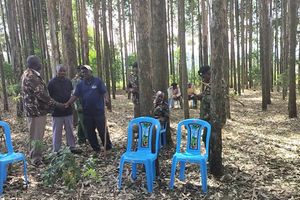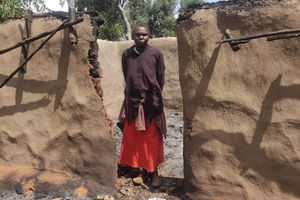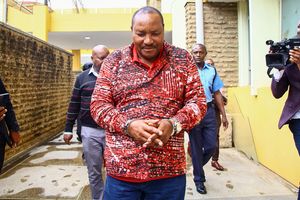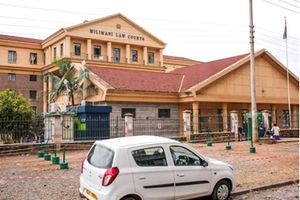Can cattle and wildlife co-exist in the Mara?
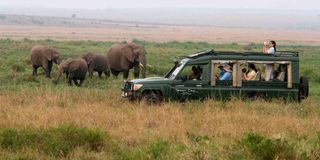
Tourists on game drive watch a herd of elephants at Musiara area of the Maasai Mara National Reserve.
What you need to know:
- Study indicating that livestock grazing doesn't hurt natural resources or wild animals in the national reserve has sparked outrage.
Scientists are at each other's throats over one of Africa's most beloved landscapes, and the outcome could change life for both wildlife and the people who have called this area home for centuries.
It all started when a study titled 'Rethinking livestock encroachment at a protected area boundary' dropped in the Proceedings of the National Academy of Sciences (PNAS) last September. The paper quickly sparked outrage, with 20 scientists banding together to challenge its findings. The fuss? Whether cows and other domestic animals are harming wildlife in Kenya's famous Maasai Mara National Reserve – that stunning 1,510 square kilometre savanna in Narok County that tourists flock to for the wildebeest migration spectacle.
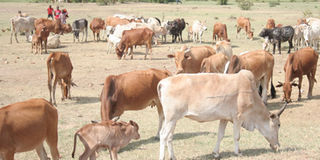
Cattle grazing at the Maasai Mara on February 12 2011. Photo/PHOEBE OKALL
Researchers Wenjing Xu and Bilal Butt, an associate professor at the University of Michigan, US, made a pretty bold claim: "Livestock grazing doesn't hurt natural resources or wild animals in the Mara." Based on this, they suggested Kenya might need to rethink keeping livestock out of protected areas altogether.
This didn't sit well with Kenyan scientist Joseph Ogutu from the University of Hohenheim, along with 19 other scientists, who fired back with their own paper: "Short-term Study Fails to Capture Negative Impacts of Livestock Intensification on Wildlife." As you might guess from the title, they weren't convinced.
Here's where things get interesting. These two research teams weren't even playing the same game when it came to their methods.
Animal poop
Xu, a postdoctoral researcher at the Senckenberg Biodiversity and Climate Research Centre in Germany, and Butt spent 19 months in the field counting animal poop (yes, really) at 60 sites across the reserve to figure out where wildlife and cattle were hanging out. They set up five straight-line paths starting near the reserve's edge and going 12 kilometres inward, checking spots every kilometre along the way.
After crunching the numbers, they reported finding "no direct associations – neither negative nor positive" between cattle and wild animals, even though they were often in the same areas. They also claimed there was "no resource degradation" near the reserve boundaries where cattle were present.
But Dr Ogutu's team wasn't having it.
"Xu’s team counted animal dung over only three hectares – that's just 0.00012 per cent of the ecosystem!" Dr Ogutu team pointed out.
To put things in perspective: "While Xu and Butt found at most 123 wildebeest dung piles per transect over 19 months and 27 cattle dung piles, the migration of 1.3 million wildebeest drops more than 10 million dung piles daily and eats over 4.8 million kilogrammes of grass each day."
In simple terms, a transect is just a fancy way of saying they drew straight lines across the landscape and walked along them to collect their data. Think of it like if you were trying to count all the trees in a forest - instead of wandering around randomly, you would pick a straight path and count everything you see along that line. It helps make your observations more systematic and less biased.
In this case, they set up five of these straight-line paths starting near the edge of the reserve and going about 12 kilometres inward, stopping every kilometre from counting animal droppings. It's basically a scientific version of 'walking in a straight line and writing down what you see' - a simple but effective way to sample a big area without having to examine every square inch of it.
Instead of 19 months of data, Dr Ogutu and friends referenced a treasure trove of evidence spanning nearly 50 years.
"Since 1977, Kenya's Directorate of Resource Surveys and Remote Sensing has done 77 ecosystem-wide aerial surveys," their rebuttal notes. And what does all that long-term data show? Wildlife populations over 15kg have crashed by more than 70 per cent (except elephants), while sheep and goat numbers have skyrocketed by 269 per cent.
The Dr Ogutu team also thinks Xu and Butt got lucky with unusually wet weather during their study, which might have temporarily made everything look more harmonious than it actually is.
It's complicated – really complicated
In an interview with Climate Action, Dr Ogutu acknowledged this isn't a black-and-white issue: "At first glance, this stance may seem contradictory since archaeological evidence shows pastoralists and wildlife have lived together in the Mara for at least 4,000 years."
He even admits cattle can be helpful in certain situations: "When kept at low numbers, livestock can actually benefit wildlife by keeping grass tender, nutritious, and actively growing – conditions that smaller grazers like gazelles love. This short grass also helps these animals spot predators more easily."
So, what's the problem?
"At high densities, livestock outcompete wildlife, cause overgrazing, promote soil erosion, and create more human-wildlife conflicts. The real issue is that livestock owners and park managers either can't or won't manage livestock numbers to keep them at those beneficial low to moderate levels," he said.
The Maasai Mara Reserve was created back in 1948 by British colonial administrators. Xu and Butt don't ignore this history, noting: "After being displaced, many Maasai feel morally justified to access resources inside protected areas because of ancestral claims and customary rights."
For many local herders, bringing livestock into the reserve isn't about politics – it's about survival, especially as other grazing lands have been fenced off or converted to other uses. This has created some tense standoffs between herders and rangers.
Dr Ogutu's team brings up a practical concern that can't be ignored – cash.
"In 2023, the reserve generated over $33.5 million (about Sh4.4 billion) in fees, making up 91 per cent of Narok County's total revenue," they point out. "That money comes primarily from tourists who come to see amazing wildlife."
Their worry? More livestock could mean less wildlife and fewer tourist dollars. Dr Ogutu warns that Kenya has seen this move before.
"Since the late 19th century, Kenya's experience has made one thing clear – areas that lose their protected status end up losing most of their wildlife," said Dr Ogutu.
He points to specific examples like "the former Amboseli National Reserve, Ngong National Reserve, West Chyulu Game Reserve, and Kitengela Conservation Area – all once amazing wildlife spots before they lost their protected status."
Finding middle ground
Despite their heated disagreement, both sides realise this isn't simple.
Xu and Butt call for approaches that "holistically consider herbivore ecology, local land use history, and modern politics of protected area management."
Dr Ogutu acknowledges reality, too: "Livestock remains crucial to pastoralist livelihoods and, if properly managed, can support both their wellbeing and wildlife conservation. But there are so many dramatic changes happening around protected areas like the Mara – not just livestock – that continue to threaten wildlife."
His team supports "sustainable livestock levels and pastoralist livelihoods inside the multi-use areas of the ecosystem" while suggesting that core protected areas should stay livestock-free.
With protected areas covering only about eight per cent of Kenya's land, these spaces provide critical refuge for wildlife populations that have already disappeared from many other regions.

